The Hidden Islands: How Many Islands Does the Philippines Really Have? And Why Does it seem like its always changing?
The Philippines is an archipelago in Southeast Asia. Being located at the Pacific Ring of Fire, one of the most intriguing aspects is its vast collection of islands. The official number of islands has been a subject of fascination and debate, but it is widely accepted that the Philippines consists of over 7,600 islands. This dynamic number reflects the geographical and geological processes that continually shape the archipelago. Let’s delve into the exact count of these islands, their cultural significance, and the phenomenon of newly forming natural islands and growing disputes.
Counting the Islands (Who is out there counting?)
Philippine National Mapping and Resource Information Authority (NAMRIA) (aka Pambansang Pangasiwaan sa Pagmamapa at Dulugang Kaalaman) is an agency of the Philippine government under the Department of Environment and Natural Resources responsible for providing the public with mapmaking services and acting as the central mapping agency, depository, and distribution facility of natural resources data in the form of maps, charts, texts, and statistics.
NAMRIA announced that it had identified 400 to 500 additional land features that might be considered islands. The count of islands was at 7,107 in 1945, and was updated to 7,641 in 2017. This number can vary due to factors such as tidal changes, rising sea levels, and advanced mapping technology. Historically, the number of islands was often cited as 7,107, but more precise satellite imaging and exploratory missions have revealed additional landmasses, updating the official count.
The meticulous process of mapping and recognizing these islands involves both technological advancements and rigorous fieldwork. Satellite imagery, GPS technology, and on-ground verification play crucial roles in identifying and categorizing islands. Each landmass, regardless of its size, contributes to the rich tapestry of the Philippine archipelago.
Cultural Significance
The islands of the Philippines are not just geographical entities; they are the lifeblood of the nation's cultural heritage. Each island, with its unique customs, languages, and traditions, adds to the mosaic of Filipino identity. The major islands, such as Luzon, Visayas, and Mindanao, host diverse ethnic groups with distinct cultural practices.
Festivals are a prominent feature of island culture. The Ati-Atihan Festival in Panay, Sinulog in Cebu, and Kadayawan in Davao celebrate indigenous heritage, historical events, and the bountiful harvests. These festivals, marked by colorful costumes, traditional music, and communal dances, highlight the deep connection between the people and their islands.
The indigenous tribes, such as the Igorot in Luzon, the Mangyan in Mindoro, and the Tausug in Sulu, showcase the rich cultural diversity that exists within the archipelago. Their customs, crafts, and oral traditions provide invaluable insights into the historical narratives and social structures that have shaped the Philippines.
Many islands bordering Philippine’s neighbors are also culturally or historically related. Such an example is Sabah. The historical relationship between Sabah and the Philippines is complex and deeply rooted. The Sultanate of Sulu, a historical kingdom that included parts of the southern Philippines, once exercised sovereignty over Sabah. In the 19th century, the Sultanate leased Sabah to the British North Borneo Company. This lease later evolved into British colonial control and eventually Sabah's incorporation into Malaysia in 1963. The Philippines has maintained a historical claim over Sabah, citing the original lease agreement. This claim has influenced diplomatic relations between the Philippines and Malaysia. Despite the claim, both nations have continued to foster cooperative relations, particularly in trade, security, and cultural exchange.
Growing Natural Islands and Disputes
An interesting aspect of the Philippines' ever-changing landscape is the formation of new natural islands. Volcanic activity, tectonic movements, and sediment deposition are primary forces behind the creation of new landmasses. The Philippines is part of the Pacific Ring of Fire, making it prone to volcanic eruptions and seismic activities that can lead to the birth of new islands.
A notable example is the emergence of new islands in the aftermath of volcanic eruptions. The 1991 eruption of Mount Pinatubo, one of the most significant volcanic events in the 20th century, led to the formation of several new landforms due to the massive deposition of volcanic materials. Similarly, underwater volcanic activity has occasionally resulted in the surfacing of new islands in regions like the Bicol Peninsula.
Climate change and rising sea levels also influence the dynamics of island formation. In some cases, coral reefs grow and accumulate sediments, eventually rising above sea level to form new islands. These natural processes underscore the dynamic and evolving nature of the Philippine archipelago.
Looking at current political disputes over the Spratly Islands in the West Philippine Sea is a complex and longstanding issue involving territorial claims and sovereignty. The Spratly Islands, a group of islands and reefs, are claimed wholly or partially by multiple countries, including the Philippines, China, Vietnam, Malaysia, and Brunei. The conflict primarily centers on competing claims to maritime rights, strategic waterways, and potentially vast underwater resources. In 2016, an international tribunal under the United Nations Convention on the Law of the Sea (UNCLOS) ruled in favor of the Philippines, stating that China's historical claims had no legal basis. However, China has rejected the ruling and continues to assert its claims through various means, including the construction of artificial islands and military installations. This ongoing dispute has significant implications for regional security, international maritime law, and diplomatic relations among the involved nations.
Exploring the islands of the Philippines is not just a journey through beautiful beaches and lush landscapes, but also a profound immersion into the history, culture, and natural wonders that make this nation unique. Whether you are a traveler, a cultural enthusiast, or a nature lover, the Philippine islands offer an unparalleled experience that is both culturally enriching and awe-inspiring.


























On October 11, 2025, Maureen Blanquisco officially carved her name in the Bodybuilding hall of fame with her 1st place victory at the Ms. Olympia Bikini competition. This 2025 win made her a 2x champ in the sport, which is an accomplishment only held by 3 other women in bodybuilding history.
Read More